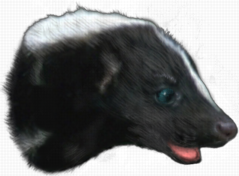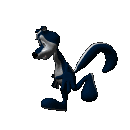
 | TheSkunkStripe Skunk pictures, facts, and much more! |
Defense
All skunks when threatened, spray a noxious smelling musk at their attacker. While the musk is composed of several chemicals that produce revolting smells, the primary one is trans-2-butene-1-thiol. Aside from the dreadful smell, if the musk gets into the eyes, it will cause a temporary stinging sensation. The extreme nausea it induces is only matched by the difficulty in removing it. Traditionally, the way of removing the smell has either been to wait until it finally dissipates on its own, or in the case of clothing, to throw it away!

Image Source: Photo taken by The Skunk Stripe at the San Bernardino County Museum, with permission.
Available in two sizes:
1024 x 768 || 800 x 600
The musk is stored in two large scent glands near the anus. Each scent glad has an associated nipple that the musk is sprayed from. There is one on the left side of the anus, and the other on the right side. Muscles around the scent glands allow the skunk to aim its spray with a great degree of accuracy. In fact, a skunk can hit a target up to fifteen feet away! Normally, a skunk will aim for the eyes of whatever animal is threatening it, but if the threat is not within sight, a skunk will instead spray a cloud of musk that the pursuing animal will have to run through.
A skunk only has enough musk at any time for about five sprays. Since it can take up to two weeks to completely refill its scent glands, spraying musk is a last line of defense. When threatened, a skunk's first reaction is to run away. If the skunk feels trapped, it will face its attacker and stamp its feet and growl. A Spotted Skunk will even do a handstand-- pointing its rear over its own head. The Stink Badger will sometimes feign death like a opossum, but always with its rear pointed at the threat... just in case! All of the actions serve the same purpose as a rattlesnake's rattle-- to warn the animal that it's both able and willing to defend itself if attacked. So effective is the combination of warning and musk, that most predators will leave a skunk alone. Skunks seem to realize this, as they have a very nonchalant attitude.

Image Source (skunk only): Robert Barber/Painet Inc., Illinois Department of Natural Resources.
Available in two sizes:
1024 x 768 || 800 x 600
Despite this potent defense, the skunk isn't without preditors. Occasionally a wolf, fox, or bobcat will kill a skunk, but the main danger is from birds of prey. Hawks, falcons, and owls have excellent vision and hunt mainly by sight. One thing they don't have is a good sense of smell. Lacking this, they have never learned to fear skunks. The Great Horned Owl, in particular, makes the skunk a mainstay of its diet, and is the single greatest predator of skunks.
 |  |

Member of Fohn.net
